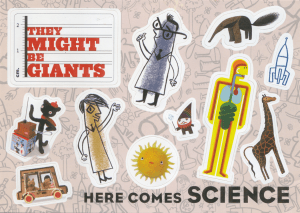Last week I promised I’d address The Problem of Dinosaurs in my next post. Then this past weekend I got to see my sister, who started and runs a school for infants thru pre-K-ers, and she had some great ideas for such a post—but they will take a bit longer to execute. So…dinosaurs will have to wait. Patience, T-Rex, patience!
For this week’s post, I decided I’d purchase and listen to an album that came out last year, and that I’ve had on my mind ever since: “Here Comes Science,” by a band that was my all-time favorite when I was in eighth grade, They Might Be Giants. TMBG have been making kids’ albums for a while now, including “Here Come the ABCs” and “Here Come the 123s”, and they have a deal with Disney, which we won’t hold against them. I bought “Here Comes Science,” which came complete with a DVD of music videos for each song, at a.k.a. music in Philadelphia, around the corner from the Chemical Heritage Society. As I walked out the record store’s door, the clerk called after me “Learn a lot!”
So what exactly is this album teaching? When I gave this CD to a friend who was about to have a baby, she thanked me for what she called the “science propaganda.” Now that I finally have it myself, I see what she meant. This record doesn’t just use elementary school science topics to create funny songs—though it certainly addresses the full range of classic subjects, from the order of the planets (“How Many Planets?”) to the colors of the spectrum (“Roy G. Biv”) to dinosaurs (“I Am a Paleontologist,” which features some truly adorable animation of a flock of kids riding dino skeletons to a museum).
It also tries to teach kids some more ambitious lessons about how science works, and why science is cool. Thus, there’s a song called “Why Does the Sun Shine?”, which is a previously released cover of a song first released in 1959. (The original was by Tom Glazer, on an album called “Space Songs,” which apparently appeared in a series of records for kids called “Ballads For the Age of Science.” I smell a primary source to add to the dissertation pile…) “Why Does the Sun Shine?” is immediately followed in the album’s lineup by “Why Does the Sun Really Shine?”, which revises the song’s original message (“The sun is a mass of incandescent gas”) to reflect new scientific ideas (“The sun is a miasma of incandescent plasma”). The song may be the only kids’ tune ever to include the line “That thesis has been rendered invalid.” The video for this song features scientists in a mountain lab, contesting theories back and forth.
There’s also a song called “Put It to the Test,” which is about finding out answers to “questions that bother your brain” through the scientific method. The song ties scientific thinking to anti-authoritarianism and empowerment: “Are you sure that thing is true?/Or did someone just tell it to you?/Test it out!” The lyrics encourage kids to take the means of gaining knowledge into their own hands. I thought the word “right” was interestingly used here: “Don’t believe it cuz they say it’s so/If it’s not true you have a right to know.” Science as a tool for full citizenship and mental liberation: very John Dewey. Plus, the video, which is done in the style of an old-school video game, is pretty funny.
But the number one most interesting song on the album was the first one: “Science is Real.” This one frames the rest of the songs, like one of those leadoff “Hook/Significance of Topic” paragraphs recommended for student essay writers. Significance: You should learn about science, and find it interesting, because it can give you the real Truth.
Note the section of this song in which the kid sitting under the tree rides away on the unicorn. Lyrics:
I like those stories
About angels, unicorns, and elves
I like those stories
As much as anybody else
But when I’m seeking knowledge
Either simple or abstract
The facts are with science
The facts are with science
I am putting together a chapter on non-fiction science books and their place in kids’ reading lives in the 1920s and 1930s, and I have been fascinated by the idea that some adults wanted to replace fantasy tales (like those with “unicorns” or “elves”) by straight non-fiction. For example, at the Brooklyn Children’s Museum, which had a library full of books about science and history, the librarians reported with some pride that the children gravitated toward the non-fiction tomes, even when fiction was available. Why is it important that these kids could get the kind of absorptive reading experience from science as they did from fairy tales or novels? What was the adult investment in believing that their Modern Children were truly interested in reality itself? (One series of science books published around this time was called The Romance of Reality.) Is it simply that science was thought to have more use value (in kids’ daily lives, or in their future lives) than fiction? And how does science fiction fit into this picture?
I leave you with one final TMBG video, for their song “The Ballad of Davy Crockett (In Outer Space)”…note the animation’s use of classroom imagery, including the paper-plate solar system mobile.

